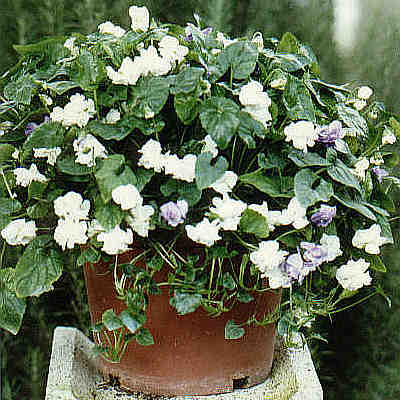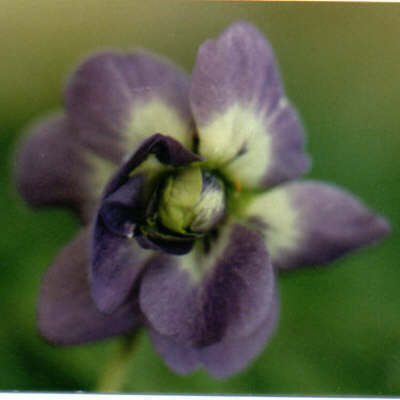|
Parma violets are the exotic members of the violet family. They appeared in Italy, in the 16th century,
introduced by the Bourbons (the ruling dynasty of the times) who in turn brought them from Spain or Portugal.
The origins of this plant are still shrouded in mystery. Some experts claim they originate in North Africa while
others believe they come from the Near East. Whichever proves to be true, the fact remains that these plants
originate in a warm climate as all of them are, without doubt, sensitive to cold weather and should be given
protection in winter, usually in a cold frame or greenhouse.
First imported into Naples, the parma was taken by Count Brazza to Udine in the latter part of the 19th century.
Rumor has it that he made deliberate crossings with parmas. Unfortunately for us, no records are left of his work.
We do know, however, that one of these parmas is still with us. Count Brazza gave the violet collector two
important parmas, one of which is still available. I suspect the other is waiting to be re-discovered.
There is one myth surrounding these plants. It claims they are sterile and can only be produced from cuttings.
Armand Millet, the French violet grower, proved this myth untrue. In recent years, it was also proven
wrong by my own father's huge collection. If conditions are right and the plant is happy and healthy, you will
find some day a see pod on one of your parma violets, so keep your eyes open.
|
Comte De Brazza
|

|
|
Photo Copyright:
|
M. P. Barandou © 2000
|
All Rights Reserved.
|
|
|
Photo Courtesy of M.Pierre Barandou, Geraniums d'
Aquitaine, S.A., Agen, France
|
|
|
Parme De Toulouse
|

|
|
Photo Copyright:
|
M. P. Barandou © 2000
|
All Rights Reserved.
|
|
|
Photo Courtesy of M.Pierre Barandou, Geraniums d' Aquitaine,
S.A., Agen, France
|
|
|
The list of current "parma" cultivars is as follows:
COMTE DE BRAZZA - The ONLY white parma in existence today, and in some circles still wrongly referred
to as 'Swanley White'. This cultivar has a very strong constitution, pure white flowers which in some climates produce
pale blue tips in petals exposed to strong spring sunlight. It has a sweet perfume.
D'UDINE - An Italian introduction at the turn of the century, and possibly named after the region in which Count
Brazza lived. Probably a sport from 'Venice,' the second of Count Brazza's parma violets. Large blue flowers with a
good strong perfume.
DUCHESS DE PARMA - Large lavender blue flowers. Good stem length and perfume. This is probably another cultivar
named after Marie Louise of Habsburg who was at one time, Duchess of Parma.
GLOIRE DE VERDUN - Dark lavender flowers with a good perfume. Introduced in the UK by my father, Mr. Jack Robinson.
This particular cultivar's origins are a little sketchy but they came from a collection in France.
HOPLEYS WHITE - This is NOT a "parma" violet despite being advertised as such by a number of violet outlets.
It was imported into the U.K. some twenty-five years ago by the then owners of Hopleys Plants, who discovered it along with
'Double Blue' in New Zealand. We have grown it, and compared it to descriptions of the old double violets written about
throughout history. The conclusion is that it is possibly the "old double white" or a sport thereof, as these were reputed
to have leaves very much like a modern parma as described by Sir Francis Bacon and others.
LADY HUME CAMPBELL - In the past, some growers considered this parma to be a synonym for 'Parme de Toulouse' or
'Gloire de Angouleme' which was imported into the U.K. at the end of the nineteenth century, by a lady of the same name and
presumably named after her. Lavender flowers with a good strong perfume, flowering later than the 'Parme de Toulouse,' of
which it could be a sport.
MARIE LOUISE - Named after Marie Louise of Habsburg-Lorraine, second wife of Napoleon Bonaparte, and Duchess of Parma.
This is the most widely grown and famous of all parma violets. Its rich blue flowers have a small red splash on the inner
rosette, and a really strong perfume. Some of the cultivars offered under this name could in fact be 'New York,' a sport
from Marie Louise, although in recent times, I have seen this beautiful plant listed as 'Marie Louise-Baden'. Obviously,
someone is trying to append an extra suffix to an extinct name in order to introduce it as a new species. Why? I am at a
loss to understand.
NEAPOLITAN - A very early form of the parma violet with pale lavender flowers. It is known to produce single flowers
under certain conditions, notably late in the season. More correctly known as
'Pallida Plena.'
PARME DE TOULOUSE - The cultivar offered today under this name is micro-propagated from original stocks, which had
become diseased. Mid-lavender blue flowers and very fragrant, this parma was thought to have been introduced to France by
soldiers who fought in Italy, and is considered to be one of the original Parma violets.
|